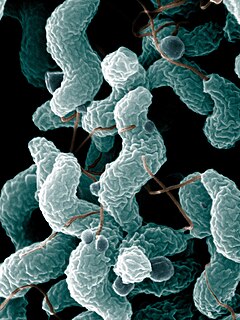Related Research Articles

Enterococcus is a large genus of lactic acid bacteria of the phylum Firmicutes. Enterococci are gram-positive cocci that often occur in pairs (diplococci) or short chains, and are difficult to distinguish from streptococci on physical characteristics alone. Two species are common commensal organisms in the intestines of humans: E. faecalis (90–95%) and E. faecium (5–10%). Rare clusters of infections occur with other species, including E. casseliflavus, E. gallinarum, and E. raffinosus.

Archaeoglobaceae are a family of the Archaeoglobales. All known genera within the Archaeoglobaceae are hyperthermophilic and can be found near undersea hydrothermal vents. Archaeoglobaceae are the only family in the order Archaeoglobales, which is the only order in the class Archaeoglobi.

Haemophilus is a genus of Gram-negative, pleomorphic, coccobacilli bacteria belonging to the family Pasteurellaceae. While Haemophilus bacteria are typically small coccobacilli, they are categorized as pleomorphic bacteria because of the wide range of shapes they occasionally assume. These organisms inhabit the mucous membranes of the upper respiratory tract, mouth, vagina, and intestinal tract. The genus includes commensal organisms along with some significant pathogenic species such as H. influenzae—a cause of sepsis and bacterial meningitis in young children—and H. ducreyi, the causative agent of chancroid. All members are either aerobic or facultatively anaerobic. This genus has been found to be part of the salivary microbiome.
In taxonomy, the Thermoplasmata are a class of the Euryarchaeota.
In taxonomy, the Thermoplasmatales are an order of the Thermoplasmata. All are acidophiles, growing optimally at pH below 2. Picrophilus is currently the most acidophilic of all known organisms, being capable of growing at a pH of -0.06. Many of these organisms do not contain a cell wall, although this is not true in the case of Picrophilus. Most members of the Thermotoplasmata are thermophilic.
Rubrobacter is a genus of Actinobacteria, given its own subclass (Rubrobacteridae). It is radiotolerant and may rival Deinococcus radiodurans in this regard.
Sphaerobacter is a genus of bacteria. When originally described it was placed in its own subclass (Spahaerobacteridae) within the class Actinobacteria. Subsequently, phylogenetic studies have now placed it in its own order Sphaerobacterales within the phylum Chloroflexi. Up to now there is only one species of this genus known. The closest related cultivated organism to S. Thermophilus is the Thermomicrobium Roseum and has an 87% sequence similarity which indicates that S. Thermophilus is one of the most isolated bacterial species.[4]

The Paenibacillaceae are a family of Gram-positive bacteria.

Epsilonproteobacteria are a class of Proteobacteria. All species of this class are, like all Proteobacteria, Gram-negative.
The family Cytophagaceae is composed of eleven genera of environmental bacteria. The proposed genus "Allopseudarcicella" was recognized as a later synonym of Aquirufa and its sole species "Allopseudarcicella aquatilis" was transferred to the species Aquirufa nivalisilvae.
The Negativicutes are a class of bacteria in the phylum Firmicutes, whose members have a peculiar cell wall with a lipopolysaccharide outer membrane which stains gram-negative, unlike most other members of the Firmicutes. Although several neighbouring Clostridia species also stain gram-negative, the proteins responsible for the unusual diderm structure of the Negativicutes may have actually been laterally acquired from Proteobacteria. Additional research is required to confirm the origin of the diderm cell envelope in the Negativicutes.
Paenochrobactrum is a genus of Gram-negative, oxidase-positive, non-spore-forming, nonmotile bacteria of the family Brucellaceae.
Paenochrobactrum gallinarii is a bacterium of the genus Paenochrobactrum which was isolated from air of a duck barn in Berlin.
Paenochrobactrum glaciei is a bacterium of the genus Paenochrobactrum reclassified from Pseudochrobactrum glaciei.
Pseudochrobactrum asaccharolyticum is a Gram-negative, oxidase-positive, non-spore-forming, nonmotile bacterium of the genus Paenochrobactrum.
Pseudochrobactrum kiredjianiae is a bacterium from the genus of Paenochrobactrum which was isolated in Nelson in New Zealand.
Pseudochrobactrum lubricantis is a Gram-negative, oxidase-positive, non-spore-forming, rod-shaped, nonmotile bacterium of the genus Paenochrobactrum, which was isolated from water mixed metal-working fluid in Germany.
Pseudochrobactrum saccharolyticum is a bacterium from the genus of Paenochrobactrum which was isolated from industrial glue.
Ancylobacter is a genus of aerobic bacteria from the family of Xanthobacteraceae.
Erythrobacteraceae is a bacterium family in the order of Sphingomonadales.
References
- 1 2 LPSN lpsn.dsmz.de
- ↑ UniProt
- ↑ Kampfer, P.; Scholz, H.; Huber, B.; Thummes, K.; Busse, H. -J.; Maas, E. W.; Falsen, E. (2007). "Description of Pseudochrobactrum kiredjianiae sp. nov". International Journal of Systematic and Evolutionary Microbiology. 57 (4): 755–60. doi: 10.1099/ijs.0.64714-0 . PMID 17392201.